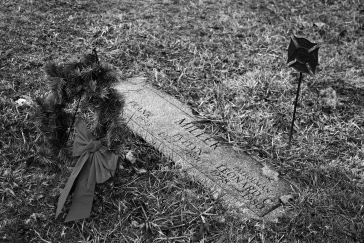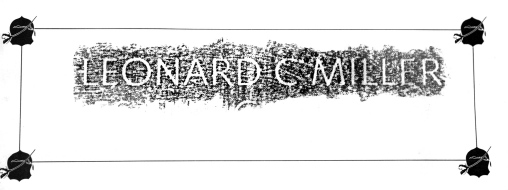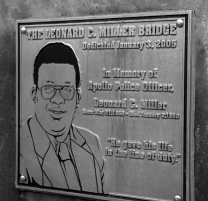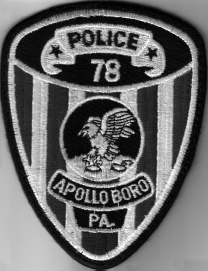Kill for Thrill (14 page)
Authors: Michael W. Sheetz
Tags: #Kill for Thrill: The Crime Spree that Rocked Western Pennsylvania

36. Riverside Cemetery as it appears today in Kiski Township, Pennsylvania.

37. Leonard Miller’s well-tended grave, where he is buried with his father, Frank, and mother, Evelyn.

38. A hand rubbing taken from the granite memorial at the National Police Memorial in Washington, D.C.
Rubbing courtesy James D. Clawson
.

39. The memorial plaque commemorating the dedication of the Apollo Bridge in honor of Leonard Miller.

40. The current Apollo Borough Police shoulder patch. Early in 1979, Leonard Miller himself redesigned the Apollo shoulder patch to incorporate the flying eagle commemorating the Apollo lunar landing. At the time of his death, the patch had not yet been adopted, and shortly after his death, officials added his badge number and issued the shoulder patch as the official insignia of the Apollo Borough Police Department.
Patch courtesy James D. Clawson
.
ART
III
S
ERGEANT
T
RIDICO
C
ONNECTS THE
D
OTS
As he approached the doors, Chuck Veshinfski noticed that something was slightly out of place. Randy, always hovering over his paper at this hour, was nowhere to be seen. Curiosity aroused, Chuck hesitated. As he stood there in the morning twilight, staring through the glass, two suspicious-looking men appeared from behind the counter.
Chuck knew instantly that the scruffy-haired pair must be robbing the place. Remembering the old adage about discretion being the better part of valor, Veshinfski withdrew to the safety of his car. He fumbled in the glove compartment for a piece of paper and started to scribble as fast as he could. The only other car in the store parking lot was a dark brown Ramcharger with a light brown roof and curtains hanging in the side windows. He wrote down the description, tossed the pen and paper on the seat beside him and slipped his car into drive, easing out onto the highway. Chuck Veshinfski drove home, picked up the telephone and called the police. Within minutes, Trooper Michael Steffee was headed toward the 7-Eleven on Route 286.

Wednesday, January 2, 1980, 11:00 p.m.
For Tom Tridico, January 2, 1980, would prove to be a turning point of sorts. For the seasoned investigator, crucial clues would surface today that would help pull together the threads of fabric that would lead him into a head-on confrontation with pure evil.
When he arrived at his office at Troop A headquarters in Greensburg, he did what he did every morning: hung his jacket, poured his coffee and grabbed the log sheet from the day’s previous assignments. Settling into his chair, he began to thumb through the list of cases.
He hated being responsible for overseeing investigators. The reports, the paperwork, all of it meant time away from what he loved—investigations. As he ploddingly thumbed through the report, he made mental notes about each case. Some had witnesses; some had no leads at all. If a case had a witness or a lead, he dropped it into a pile marked “follow up.” Everything else went into the “inactive” bin. Chuck Lutz’s report on the Sonny’s Lounge burglary, which he already knew about, landed on the “follow up” pile. Michael Steffee’s armed robbery report from the 7-Eleven convenience store landed there too. He continued to the bottom of the pile. After quickly evaluating the last case, he unceremoniously dropped it into the “inactive” bin.
With the daily assignments complete, he got up from his chair and gathered what he would need for the day ahead. He was anxious to meet with Dickey and Boyerinas to discuss their search of Michael Travaglia’s repossessed truck. He was sure that what they found would move the Levato case forward. As he threw his coat over his arm and flipped off the light in his office, Tom Tridico saw the frozen face of Peter Levato in the back of his mind.
The weather was gray and overcast. Tom’s thirty-minute drive out Route 66 from Greensburg through Mamont, past Beaver Run and into North Washington to the Kiski Valley Barracks gave him time to think. Today was no different from any other day. Thirty degrees and light snow had been the prediction. No snow yet, but the sky was right for it, Tom thought as he rolled through the countryside. Today was no different from any other day.
When Tom arrived at the barracks, Rich Dickey and George Boyerinas were already waiting for him—as usual. Tom walked into the tiny squad room and over to where Dickey was seated. Rich glanced up and then slid a brown paper bag toward him.
“The contents of Travaglia’s truck,” he said.
Tridico tossed his coat on the back of the closest chair and unfolded the lip of the bag. He dumped the contents on top of the desk: a toy gun, a ski mask, some yellow electrical wire, a set of homemade rope handcuffs and some papers. Picking up the plastic evidence bag containing the wire, his mind reached for the stack of reports in his office. In his mind, he lifted Trooper Mike Steffee’s from the top of the pile and examined it.
“Steffee had a robbery yesterday out on 286,” he said. “Clerk was tied up with yellow wire.”
Tom slid his glasses down on the bridge of his nose for a closer look at the wire: “Carol Cable.” He made a mental note to check Steffee’s report more closely and then dropped the wire back onto the desktop.
Sifting through the papers, Tridico picked up several, skimming over them: letters, bills, phone numbers. They were an assortment of the details that make up a man’s life. As he shuffled through the bits of Michael Travaglia’s life, a slip of paper dropped out of the stack and landed on top of the desk.
It was blank except for the name “Ray Scalese” followed by a phone number. Tom studied it for a moment and then raised his eyes toward Rich Dickey. “Check this guy out,” he said. Dickey nodded, and Tom dropped the papers back onto the desktop.
Chuck Lutz walked into the squad room to join the other men. Hired back in the days before EEOC (Equal Employment Opportunity Commission), when state troopers were required to be over six feet tall, Chuck was an imposing figure, rough-hewn and rustic, with a full head of salt-and-pepper hair. He dropped his notebook onto a desk and quickly walked toward Tridico and the other men. He thrust a stack of papers toward Tom.
“Arrest warrant for Travaglia,” he said, “for the Sonny’s Lounge burglary. It’ll give us enough to pick him up until we can make him for that Levato thing.”
Tridico carefully studied the warrant. Everything seemed to be in order. He handed it back to Lutz. “I’ll send out the teletype. Maybe we can round this guy up.” Tridico grabbed his coat off the chair and started toward the door. “But right now, I’m heading out to this kid’s last known address.” He disappeared down the hallway. “I’ll let you know what I find.” His voice echoed down the hall and faded away.
Tom headed toward the village of Chambers, a collection of middle-class homes spread out over a two- or three-mile patch of land sandwiched between the Beaver Run and Route 66. A mile and a half from Apollo, Chambers sits atop a slight plateau overlooking the Kiskiminetas River. He made a sharp right onto Chambers Street and then slowed his cruiser to a crawl. He looked for street signs.
The few signs that did exist were old and weathered. They offered little help. He crawled along until he reached the end of the road. There was nowhere else to go—it was either right or left. On the northwest corner, he spotted a sign—Fourth Street. He made the right turn and then headed for the only house on the east side of the street.
The Travaglia homestead was purchased in 1960 by Bartolo, Joseph and Bernard Travaglia. It sat slightly off the gravel roadway, crowded up against the tree-covered hillsides that look down on a small ravine cut into the rocky hillside. A winding offshoot of the Kiskiminetas River has carved its way toward the Beaver Run Reservoir, eating away at the hillsides and creating this quaint plateau of ground.
A tidy, two-story structure with a shingle roof, Michael Travaglia’s boyhood home sat patiently, waiting and watching, as Tom stepped out of his car and walked along the frosty grass leading to the front door.
Once inside, Tom quickly covered the perfunctory formalities that made up the who, what and why of his visit and then launched gently into a measured series of questions. Tom didn’t want to telegraph more details than necessary, but he gently probed the senior Travaglia for vital bits of information that he hoped would bring some closure for Peter Levato.
Bernard Travaglia’s wary answers to the questions Tom posed signaled a growing concern over his son’s recent behavior. Tom watched Bernard’s face flush as he slowly revealed that Michael had owned a .22-caliber handgun. He swallowed hard, paused and, with a hint of hope, said that Michael had been hunting in Ligonier a while back, and a game warden had confiscated the weapon. Tom voraciously scribbled notes. Bernard’s voice dropped an octave as he added, “At least that’s what Michael said.” Tom felt the older man’s pain. He was a father, too. He understood how it must have felt for Bernard to slowly realize that his child could be capable of murder.
Tom knew that silence is an interviewer’s strongest weapon, so he paused. He waited for that uncomfortable silence to grow so painful that Bernard couldn’t let it continue.